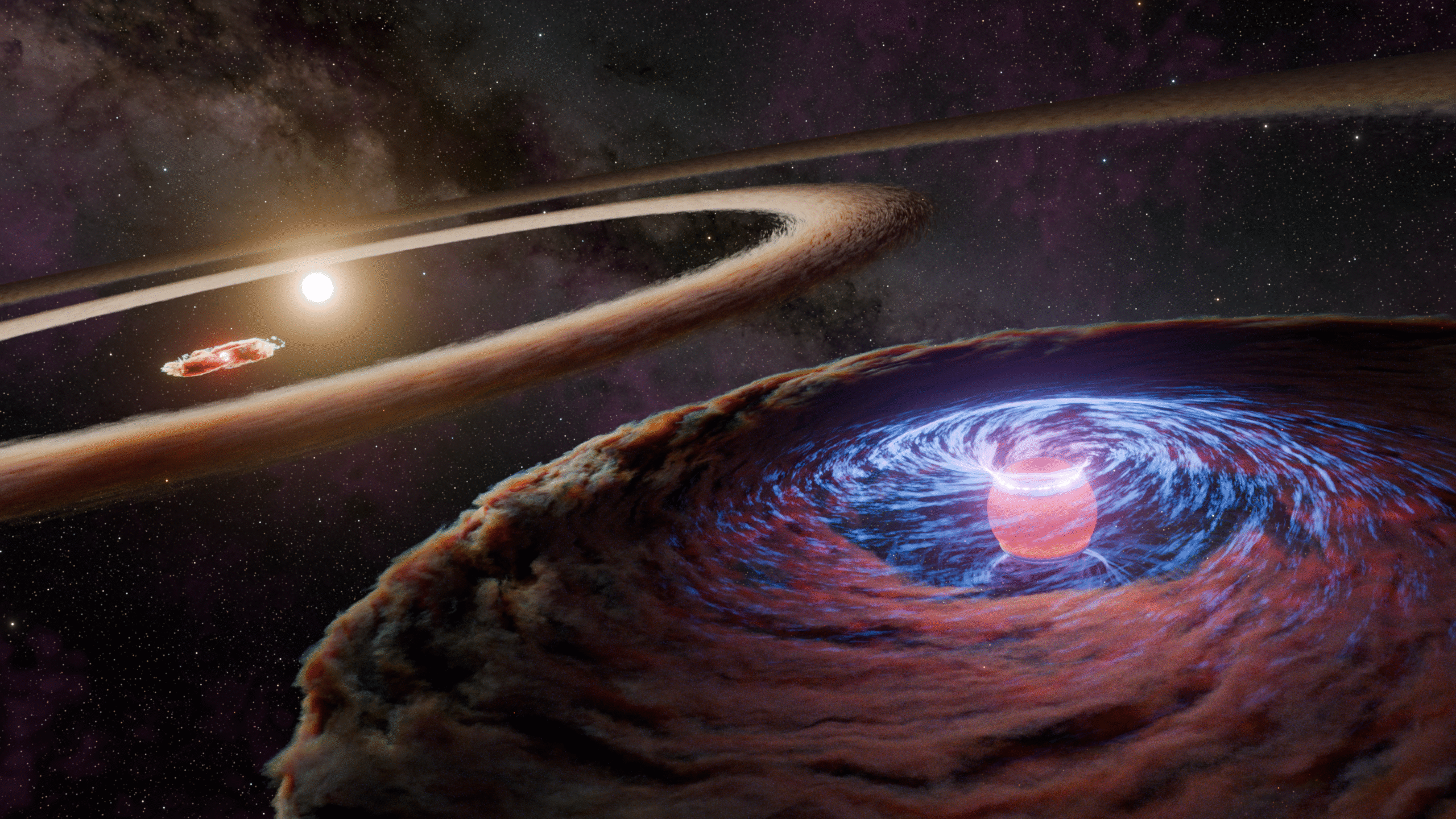Jupiter’s Auroras: A Stunning Light Show Beyond Earth

WISPIT 2b: A Newly Discovered Protoplanet in a Ring Gap
Astronomers have directly detected a young protoplanet called WISPIT 2b, located about 437 light-years from Earth. This remarkable discovery marks the first confirmed observation of a planet forming inside a ring-shaped gap in a protoplanetary disk. For decades, scientists suspected that planets carved out these gaps, but until now there was no direct proof.
A Giant Baby Planet
WISPIT 2b is massive, about five times the size of Jupiter, and only around five million years old — making it nearly 1,000 times younger than Earth. Despite being in its early “proto” stage, it already qualifies as a gas giant. Protoplanetary disks, like the one surrounding its star WISPIT 2, are made of dust and gas. These disks act as cosmic nurseries where young planets grow and shape their environments.
The presence of WISPIT 2b in the disk gap provides evidence that planets themselves push aside dust and gas, creating these clearings. Scientists believe that Jupiter and Saturn may have done something similar in our own solar system billions of years ago.
First Direct Image of a Protoplanet in a Disk Gap
The discovery was made using the MagAO-X extreme adaptive optics system at the University of Arizona’s Magellan 2 (Clay) Telescope in Chile. Unlike indirect detection methods, MagAO-X provided a direct image of WISPIT 2b, essentially photographing the planet.
Researchers observed the planet in H-alpha light, a visible wavelength emitted when hydrogen gas falls onto young planets. In these observations, WISPIT 2b appeared as a distinct glowing dot inside the dark ring gap of the disk. Additional infrared imaging from the Large Binocular Telescope confirmed the detection.
A Possible Second Planet
Interestingly, the team also spotted another faint dot closer to WISPIT 2. This second object is considered a candidate planet and may be confirmed in future studies.
Who Discovered WISPIT 2b?
The discovery was led by University of Arizona astronomer Laird Close and Richelle van Capelleveen of Leiden Observatory, with contributions from an international team. Their results were published in The Astrophysical Journal Letters on August 26, 2025.
The research received support from NASA’s Exoplanet Research Program, the U.S. National Science Foundation, and the Heising-Simons Foundation.
Why This Matters
WISPIT 2b is not just a fascinating baby planet. Its discovery provides the first direct proof that planets can carve out ring gaps in protoplanetary disks. This gives astronomers powerful new insight into how giant planets form and shape their surroundings – a process that may mirror how our own solar system came to be.


That’s awesome..
Great read! It’s amazing how much psychology shapes poker strategy, especially in high-stakes tournaments. For those looking to test their skills in a real-world setting, the JLJLPH Login offers a top-tier platform with live games and immersive slots that truly mirror the intensity of competitive play.
I read it as aura at first and was like planets aura farming too now?
Interesting points! Thinking about visual strategy, tools like Space Logo AI could really speed up concept development – no install needed, which is a huge plus for quick iteration & testing!
King333casino, sounds regal, right? It’s alright, not gonna lie. Could use a bit of a refresh, but the games are functional and get the job done. I’d say, manage your expectations, and you might have a good time. Check out king333casino if you are curious!
Anyone using the 8k8app11? How is it? Is it better than the website? Always on the lookout for a better mobile experience. Download the new app here: 8k8app11
Vietlottpower… another Vietlott site! I hope I win the Powerball jackpot! This one could be worth checking weekly if you’re into that kinda thing. Dreams of wealth!!!: vietlottpower
So, I decided to give lc88bet a shot and I was pleasantly surprised. They have some pretty good odds and the site runs smoothly. Plus, the signup bonus was a nice little boost! Here’s the link if you’re interested: lc88bet
King88slot… King of slots, eh? Big talk! Prove your throne’s worth sitting on with awesome graphics, great payouts, and a royal gaming experience. Rule your luck here: king88slot
Trong số các dịch vụ giải trí nổi bật mà đăng ký 66b cung cấp, chúng ta có thể kể đến: cá cược thể thao, trò chơi casino trực tuyến, xổ số và nhiều trò chơi điện tử khác. Tất cả những điều này được thiết kế để mang lại sự thư giãn và phấn khích cho người chơi, đồng thời cho cơ hội để thắng lớn.